Weekend Crossroad is excited to introduce Weekend Whims – our newest section where contributors will submit personal tips about cities where we have lived / spent considerable amounts of time.
Watch this space!
Weekend Crossroad is excited to introduce Weekend Whims – our newest section where contributors will submit personal tips about cities where we have lived / spent considerable amounts of time.
Watch this space!
Flores is my Indonesia swan song – my last major trip in the archipelago nation before heading back to the U.S. I’m just barely staying true to Weekend Crossroad’s philosophy, as between its immense size and still developing infrastructure, Flores requires considerably more a long weekend to explore properly. However, those with time constraints can always choose a couple of highlights to enjoy, as illustrated in the following multi-part Flores series. Alternatively, one can choose to take an 8-10 day overland trip from Maumere to Labuan Bajo, which covers roughly two-thirds of the island.
This is Part five of eight. Check out Part one, Flores 101: How, When and Why to Go, Part two, Flores: Singing and Swaying in Sikka, Part three, Flores: Enjoying the Multicolored Regency of Ende, and Part four: Flores: Relaxing in Riung.
Bajawa is by far the most chill place in Flores — both literally and figuratively. With temperatures dropping to as low as 12 degrees centigrade in the chilliest months of July and August, visitors will definitely need a sweater and/or light jacket. And as in Northern Sumatra, there are many Indo-Rastafarian “mountain guides” happy to lead treks or just hang out. Travelers who are athletically inclined will find no shortage of beautiful volcanoes to scale, while at the other end of the spectrum, those in search of local gastronomic delights will not be disappointed (for a change!) An excellent midpoint for your over-island adventure, Bajawa is a great place to just relax.
Heading to Bajawa from Riung, we bump along the same terrible road for several kilometers before reconnecting with the paved highway. Our first stop is Mangeruda Hot Springs, a facility which itself has seen better days, but on the plus side is delightfully empty on weekdays.
Avoid the man-made pools which are of dubious hygienic standards, and head straight for the natural falls. While short in stature, they still pack quite a punch and are used by locals for a natural massage. A quick “pit stop” should be more than sufficient unless you want an extended soak. (I quite enjoyed reading in Soa Poba Polo, the point where the hot spring meets the river, serving as a natural thermostat of sorts.)
Arriving in Bajawa, capital of Ngada Regency, we enjoy a quick lunch at Camellia Restaurant and drop off our bags at the hotel. We then head for Bena Village, located short ride away through gorgeous mountain passes and a beautiful bamboo forest.
Bena Village is one of the best-preserved examples of Ngada culture. Home to megalithic stone formations, ancestral shrines, and a small grotto dedicated the Virgin Mary, Bena at once conjures up a deep sense of history, tradition, and connection to the spiritual world. There is also a vibrant sense of life, with children playing football clad in dusty jerseys of their favorite players, and women chatting, chewing betel nut, and weaving traditional ikat sarongs and blankets.

The raised, thatched roof Ngada village houses are set up in two parallel lines, in the center of which can be found ancestral shrines – the ngadhu, representing male ancestors, and the bhaga, which serves as the female ancestral clan shrine.
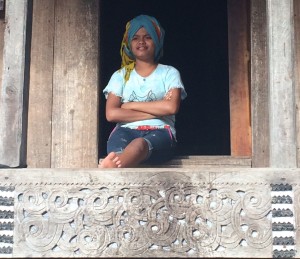 Unlike most social groups in Indonesia, the Ngada are matrilineal, meaning that children are considered to be members of their mother’s clan – and houses are bequeathed accordingly. Ancient Ngada society was organized according to strict hierarchical classes – nobility, warriors and slaves.
Unlike most social groups in Indonesia, the Ngada are matrilineal, meaning that children are considered to be members of their mother’s clan – and houses are bequeathed accordingly. Ancient Ngada society was organized according to strict hierarchical classes – nobility, warriors and slaves.
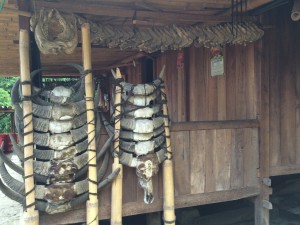
Nothing goes to waste . . . water buffalo horns, skulls, and pig jaws from ritual sacrifices are used to decorate homes.
During my visit, a flurry of building activity was going on, with workers seeking to replicate traditional processes as much as possible. (I later find out that while the site has been placed on the UNESCO World Heritage Tentative List, the villagers are striving for permanent recognition, and the organization is providing financial assistance to support this goal.)
But what really strikes me is the megalithic structures at the center of the village, which I am told continue to serve as means to connect with the supernatural realm and ancestral worship through ritual ceremonies and animal sacrifice. No one is able to tell me exactly how old they are — but the village itself dates back over 1000 years.
 The final stop is a small hill which offers a beautiful panoramic vista of Bena Village, Mount Inerie, and the volcanic valleys leading to the Savu Sea. It is crowded with local visitor, but I still found unobstructed vantage points from which to snap photos.
The final stop is a small hill which offers a beautiful panoramic vista of Bena Village, Mount Inerie, and the volcanic valleys leading to the Savu Sea. It is crowded with local visitor, but I still found unobstructed vantage points from which to snap photos.
Apart from Bena Village and hikes of varying difficulty, there is not much to “do” in Bajawa. Surprisingly this is what made it one of the more enjoyable stops for me. Taking advantage of the cooler temperatures, I took extended walks around the town and deep breaths of the crisp mountain air. I also enjoyed some of the best food I had in Flores at Lucas Cafe, where I indulged in pork sate and tempe(h) with tomato — a different style of preparation from what I typically had in Java. I had no idea what was coming up next — but had I been aware, I would have appreciated this down time all the more!
Flores is my Indonesia swan song – my last major trip in the archipelago nation before heading back to the U.S. I’m just barely staying true to Weekend Crossroad’s philosophy, as between its immense size and still developing infrastructure, Flores requires considerably more a long weekend to explore properly. However, those with time constraints can always choose a couple of highlights to enjoy, as illustrated in the following multi-part Flores series. Alternatively, one can choose to take an 8-10 day overland trip from Maumere to Labuan Bajo, which covers roughly two-thirds of the island.
This is Part four of eight. Check out Part one, Flores 101: How, When and Why to Go, Part two, Flores: Singing and Swaying in Sikka and Part three, Flores: Enjoying the Multicolored Regency of Ende.
If there is one thing to drop from your Flores itinerary, Riung would be the place. Accessible only via the narrowest and bumpiest of country roads, it is slow pickings to get to. To call even the best accommodation basic is, well, kind. Though the islands themselves are nice enough, I found snorkeling far better in the clear and shallow waters around the islands off the west of Flores (Komodo, Rinca and their ilk). The highlights for me of this segment of the trip were enjoying freshly-caught grilled tuna and snapper, floating and boating on the calm waters of the Savu Sea (known to the locals simply as the South Sea) and witnessing a colony of “flying fox” bats spread their amazing wingspans in the early afternoon. At night, the “backwardness” of the village becomes its best asset as, unfettered by light pollution, the stars in the night sky shine brilliantly and seem deceptively within one’s grasp.
After a seemingly interminable jostling ride which seems more like trailblazing than actually driving on a road, we stop by a rather nondescript patch of dirt. This, explains my guide, is why we’ve gone to all this pain. A short climb later, I find myself enjoying a panoramic vista that is marred only by armies of biting ants that seem to find my ankles particularly attractive targets. Having just seen the sunrise at Kelimutu that morning, there is a certain feeling of completeness that comes over me as I watch that very same sun descend over a completely different place.
As I scan the horizon I find myself fascinated by the frequency with which islands become national exercises in branding and public relations. Take Australia’s Twelve Apostles – stunning rock formations jutting out of the water along Victoria’s Great Ocean Road. Originally called the Sow and Piglets, the limestone outcrops were renamed in the 1920s to be more attractive to tourists. Never mind that there are actually only nine of them!
In a similar fashion, a traveler with far too much time on his/her hands may attempt to count the islands off Riung from the fantastic vantage point where I am standing. Such travelers might be surprised to find their count exceeding 17. Though this might be attributed to an excessive consumption of Bintang or worse, the local Arak palm liquor, the truth is that there are indeed 21 islands in total. However, given that the 17th of August, 1945 marks Indonesia’s independence day, such poetic license may be forgiven.
The evening passes unremarkably. The next morning we head to the rather grandiosely named “tourist harbor” to board the tiny vessel that will convey us around for the next 8 hours or so. At low tide, the pier looks like a boat graveyard, with fishing boats lolling drunkenly on their sides. Boarding the boat is an interesting experience of its own, feeling almost like a steeplechase meeting an obstacle course. But finally we are all settled in with all of the essentials – drinking water, snorkels and fins, and fresh food and vegetables for grilling later in the day.
While snorkeling abounds, the avid scuba diver may be disappointed to learn that there are no diving outfits or dive masters in Riung. The islands have been afforded marine park preservation status, which is key to maintaining its sensitive ecosystem of some 30 different species of coral as well as colorful fish and playful dolphins.
We begin the day at “Pulau Tiga” or “Third Island” (I wonder if all the islands are numbered – and later learn that in fact they’re not. . .) I languidly inflate a floating cushion which serves two purposes – first, acting as a platform for my underwater camera, and second, acting as a platform for me as I float in the sea with a trashy paperback novel. Why do even the most mundane of tasks seem easier and restful on an island?
While I am, er, hard at work, my trusty boat crew is engaged in a far more meaningful endeavor — preparing lunch!
After stuffing ourselves silly on amazing tuna and snapper, noodles, vegetables and rice, we waddle over to the boat to check out snorkeling opportunities on a couple of other small islands. Unfortunately due to changing tides the waters are a bit cloudy, so we decide to head out to the final two stops of the itinerary.
On Pulau Ontoloe, one of the larger islands, we bump into another group of tourists who are eager to hike up the large hill to enjoy the view. While I like this idea in theory. . . in practice I find that I am too hot and lazy to bother. We play a temporary game of musical guides as Janny takes them climbing, and I lounge and snorkel with the other guide.
My boat then heads for the mangroves of Kalong Island. Having recently experienced the splendor of the exodus of “wrinkle-lipped” bats from the caves at Mulu National Park in Sarawak, Borneo, Malaysia, I find myself skeptical as we approach Kalong Island, which is famed for its colony of “flying fox” bats, also known as “fruit” bats. (Exactly who gives these poor creatures their ridiculous common names anyway?!?) But the experience was unforgettable for a number reasons.
The only other times I’ve seen bats have been at night or in really dark caves. These bats are out and active in broad daylight or else can be found dramatically suspended from trees in the open air.
Finally, as we head back to shore, I am amazed by how exhausting I found a day of doing absolutely nothing. Slightly sunburned but highly satisfied, I head over to Rumah Makan Murah Muriah, pretty much the only decent place to eat in town, and fall into a deep slumber.
Next stop, Bajawa!
Continue onto part five here.
Flores is my Indonesia swan song – my last major trip in the archipelago nation before heading back to the U.S. I’m just barely staying true to Weekend Crossroad’s philosophy, as between its immense size and still developing infrastructure, Flores requires considerably more a long weekend to explore properly. However, those with time constraints can always choose a couple of highlights to enjoy, as illustrated in the following multi-part Flores series. Alternatively, one can choose to take an 8-10 day overland trip from Maumere to Labuan Bajo, which covers roughly two-thirds of the island.
This is Part three of eight. Check out Part one, Flores 101: How, When and Why to Go, and Part two, Flores: Singing and Swaying in Sikka.
Mount Kelimutu – “the Boiling Mountain” – is one of Flores’ must see attractions, both for the ethereal natural beauty surrounding its three colored crater lakes, and the mythical beliefs held by local inhabitants. Seeing the volcanoes at sunrise is a MUST – particularly since, unlike most Indonesian sunrise vistas, there are surprisingly few tourists present on weekdays, affording one a unique opportunity to enjoy nature’s broad palette.
Science
Like Lake Toba, Mount Kelimutu has both scientific and, well, not-so-scientific explanations for its creation, the ever-evolving hues of its crater lakes, and its greater purpose.
Scientifically, relatively less is known about Kelimutu than its other cousins such as Toba and Krakatau. Nearly 1,700 meters at its peak, the volcano was “discovered” in 1915 by a Dutch colonial government official. Since then, three major eruptions have been recorded – 1928, 1938, and a massive eruption in 1968 during which water from the crater lakes was projected as high as ten meters. There have been periodically heightened periods of activity over the last 20 years, but nothing nearly at these levels.
The highly acidic lakes – though beguiling – can also be lethal. In 1995 a Dutch tourist fell into the turquoise lake – and despite 5 days of search and rescue – was never found. I had to chuckle when “Kelimutu lakes swimming” was one of the Google autofill options that came up as I was researching the area. That, my friends, would not be a good idea.
Superstition
Kelimutu is considered sacred by the Lio tribe as it is believed that souls of the dead reside in the deep waters. They begin their journey at the Gate of the Spirits marked by two huge rocks symbolizing the Konde (or queen) and Ratu (or king). These guards of the gate (a sort of Florinese St. Peter if you will) assign souls to the appropriate lake based on two key criteria – their age at time of death, and the nature of their character.
Every year in August, a ceremony is held to commemorate the souls of the departed and ask for blessings and safe passage through Kelimutu in the year to come.
I learn that many of the island’s traditional belief systems are built on a delicate balance between “complementary opposites” – male/female, old/young, sky/earth, mountain/sea, etc. Spirits, generally benevolent ancestors, serve as guardians and protectors, while every once in a while, an evil spirit lurks around, leaving misfortune, destruction, illness, and death in its wake. Both groups are honored / appeased with frequent offerings.
Kelimutu is essentially a giant tempat angker, or “haunted place” where spirits gather – one of many found throughout the island. To manage these forces, each village has a dukun, or healer who through a combination of traditional medicine and ritual practices can either call up white magic for good, or black magic for bad.
Setting
The drive up in complete darkness can be a little unnerving, with sudden sharp curves, steep inclines, and eerie mists all limiting visibility. It is difficult to believe, as in much of Flores, that these are meant to be two-way streets – and the sudden appearance of headlights requires a graceful automotive dance that only the most skilled of drivers can pull off.
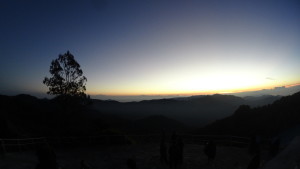 It is a bit of a hike to get to the top – 1.5 km of a relatively gentle slope followed by 127 steps to the viewing platform at the summit. All in all highly doable for people even at less than prime levels of fitness (such as yours truly). The walk up – in nearly pitch black – is almost other worldly, and frequently described by travel writers as a virtual moonscape. At the first blush of dawn, however, the vista is transformed in a way that is impossible to capture on camera. Upon reaching the viewpoint summit, the morning chill begins to sink into your bones. Fear not, however, as enterprising locals lay out blankets offering everything from tantalizingly hot ginger coffee to extra sarongs for warmth.
It is a bit of a hike to get to the top – 1.5 km of a relatively gentle slope followed by 127 steps to the viewing platform at the summit. All in all highly doable for people even at less than prime levels of fitness (such as yours truly). The walk up – in nearly pitch black – is almost other worldly, and frequently described by travel writers as a virtual moonscape. At the first blush of dawn, however, the vista is transformed in a way that is impossible to capture on camera. Upon reaching the viewpoint summit, the morning chill begins to sink into your bones. Fear not, however, as enterprising locals lay out blankets offering everything from tantalizingly hot ginger coffee to extra sarongs for warmth.
On the walk back, nature’s sounds and scents greet you as the moonscape comes alive. The drive back is harrowing for an entirely different reason — morning fog not only obscures the car’s windshield, but also makes it very hard to see beyond a couple of meters at a time. Somehow, we make it back to the Kelimutu Ecolodge in one piece, in time for a well-deserved breakfast.
 Our next stop is Penggajawa Beach, popularly known as Blue Stone Beach, in Ende. My initial reaction is slight disappointment — after the spectacularly gorgeous beaches that I’ve seen in other parts of Flores, this semi-industrial port-meets-stone-quarry stop is underwhelming. I enjoy getting up close and personal with the beach, and pick up a few small blue stones to replace my goddaughter’s mysteriously vanished mancala game stones back home. But high demand for the stones from interior designers across Indonesia and in Japan means that the once vibrantly blue beach is becoming whiter and grayer. 🙁
Our next stop is Penggajawa Beach, popularly known as Blue Stone Beach, in Ende. My initial reaction is slight disappointment — after the spectacularly gorgeous beaches that I’ve seen in other parts of Flores, this semi-industrial port-meets-stone-quarry stop is underwhelming. I enjoy getting up close and personal with the beach, and pick up a few small blue stones to replace my goddaughter’s mysteriously vanished mancala game stones back home. But high demand for the stones from interior designers across Indonesia and in Japan means that the once vibrantly blue beach is becoming whiter and grayer. 🙁
We then hit a bit of a snag. Heading out from the beach, we discover that the highway is closed for an undetermined amount of time due to construction. (This is a common occurrence across the island, incidentally.) So we pull to the side of the road, where I engage in one of my favorite Indonesian activities — truck spotting.
At long last our journey finally resumes — next stop, Riung and the 17 Islands!
Continue on to part 4 here.
Flores is my Indonesia swan song – my last major trip in the archipelago nation before heading back to the U.S. I’m just barely staying true to Weekend Crossroad’s philosophy, as between its immense size and still developing infrastructure, Flores requires considerably more a long weekend to explore properly. However, those with time constraints can always choose a couple of highlights to enjoy, as illustrated in the following multi-part Flores series. Alternatively, one can choose to take an 8-10 day overland trip from Maumere to Labuan Bajo, which covers roughly two-thirds of the island.
This is Part two of eight. Part one, Flores 101: How, When and Why to Go, can be accessed here.
For me, the highlights of Sikka regency were the vibrant ceremony at Watublapi Village just outside of Maumere, and Koka beach, whose crystal clear waters and white sands
Heading out of Maumere’s Frans Seda airport, I see a man with a gap-toothed grin holding a sign with a rough approximation of my name, featuring many additional consonants that give it an almost Icelandic flair. (Speaking of names, the airport honors the rather grandly named Franciscus Xaverius Seda, the most famous local son who served in various ministerial positions under President Suharto. I later find myself fascinated by Florensian names, many of which, like Mr. Seda’s harken back to the early Christian era in Rome.)
As I check in to my hotel in the late afternoon, I have absolutely nothing on my agenda. This is fine with me, given that I have a rather packed 10 days ahead. Indeed, there is not much to do in Maumere – despite its status as Flores’s largest town – certainly not within walking distance, anyway. For those who are so inclined, there are a number of diving resorts and operators in the area. Avid divers, however, may be disappointed to learn that between natural disasters, pollution, and the devastating practice of dynamite fishing, much of the coral in the area has been destroyed.
I am told that there is a special buffet dinner that starts at 7, and I settle into my beach bungalow with the best of intentions to rest my eyes for just a few minutes. At 7:45 I am jolted awake by lively folk music, and realize that I have overslept. The adage “you snooze you lose” proved painfully true in this instance, as by the time I stumble into the dining room there is little more than white rice and a few sad looking pieces of fish remaining. (Unfortunately, this is an all-too-common phenomenon for travelers in the region!)
At dinner, I am greeted by a florid-faced white-haired man who introduces himself as Father Heinrich. He welcomes me, and explains that the evening’s celebration is in honor of his 86th birthday. I am duly impressed and make the appropriate congratulatory remarks. Throughout my trip I note that nearly all of the higher-end tourist accommodations are expat-owned and managed, and a significant number of these individuals originally came to Flores as Catholic missionaries with a particular focus on bolstering the weak local education system.
The next morning, I am greeted by my guide and partner-in-crime for the next week, Janny (short for Johanes Marcus!). He explains that we will interact with a number of different ethnic groups throughout the week, and our first stop will be the Sikka village of Watublapi. Most tourists only stop by briefly to check out the village’s renowed ikat weaving. For me, however, there is a special surprise in store.
“Oh, helelarak! Oh, helelarak!”” Welcome, welcome! The village elder and traditionally dressed women sing and dance in a welcome ceremony to Watublapi Village in Sikka, Flores, East Nusa Tenggara, Indonesia.

Sirih pining, or betel nut, chewing, is a tradition that goes back thousands of years. Glad I tried it — but definitely not a fan. . .
After the welcoming ceremony, we are invited to eat betel nut (dipped in limestone powder crushed from local oysters), sip local arak palm wine (at 10 am!) and smoke home-grown, hand-rolled cigarettes. The former was not particularly appetizing, and happily, the small nibble that I took did not dye my teeth the dreaded red of the lifelong betel chewer. The plant itself symbolizes humility, as it grows freely without damaging its host plant. It is believed to have medicinal effects from preventing tooth decay and ad breath to curing dysentery, intestinal worms, and scabies! It is actually the lime that causes tooth reddening. However, the delicious steamed purple rice cakes that followed more than offset this!
Then the entertainment began – for both them AND me. Each dance served a specific purpose – for example, highlighting the agility of a man and the skills of a woman preparing for marriage, or keeping villagers on track and high spirited during various stages of the harvest.
To my surprise they then dressed me in a beautiful sarong and blouse, explaining the significance of each. The longer the sleeves and the greater the number of bracelets, the older you are. Elderly women wear two sarongs, while others wear only one. Deeming me middle-aged (almost!), they present me with a three-quarters sleeve blue blouse, a red and blue woven sarong, and two bracelets. (I would have been offered more bracelets had I been married/borne children, and I find my inner competitive streak inadvertently acting up!)
Then the fun / my abject humiliation begins. Resembling something between a beached whale, a dying hippopotamus, and a stampeding elephant, I emulate the graceful dancers in what can only be described as a sad parody. I rock the singing / yelling component of the performance though, and with great pride I am affirmed as a bona fide Watublapi! Happily, there are no other tourists (or worse yet, close friends/relatives of mine!) to witness this spectacle.
Next, I join two other tourists (who do not know what they had missed!) in watching the women of the village demonstrate how they harvest cotton, make natural dyes, spin thread and weave beautiful textiles using a traditional ikat method. Ikat means “to tie,” and in this process, individual threads are tied to create vibrant patterns before being immersed in dye pots, threaded onto a lap loom, and woven in into cloth. This is not merely a demonstration for tourists, as textiles form a significant source of income for the village.
A cynic might describe the experience as “a tourist trap,” but there is genuine joy in the faces of the performers, an unfeigned solemnity to the ceremonies, and the barrels of unfettered belly laughs from the local children as they watch me try (and fail!) to emulate the grace of the dancers. The weavings are beautiful and truly one-of-a-kind, offered at reasonable prices given the labor-intensive process involved in creating each one. (I ended up walking out with two purchased weavings as well as a scarf and a woven thread bracelet gifted to me by my new BFF Karolina.
Our next stop is Koka Beach – also known locally as the “twin beach.” I am initially skeptical when in the parking area I am greeted by the unfortunately all-too-common Indonesia vista of piles of rubbish and smoky cook-outs. The local children cheerfully frolicking in the water are fun to watch though. But then Janny beckons to me. “Come this way,” he says. We cross an expanse of sand to an entirely new world. For the twin beach is a broad expanse of white sand and clear water with only a single lone fisherman in sight. The vista took my breath away. Though time is allotted for swimming, the idea of sitting in a wet swim suit for the remaining 3+ hour drive to Kelimutu is less than appealing. So I am happy to explore on foot, fully clothed, the untouched beauty of this secret corner.
Our last stop for the day is at the Lio village of Woloraru, primarily to take a look at the distinctive Lio architecture and motifs. Woloraru is not a typical tourist village, and truth be told is strewn with litter and actually somewhat depressing. It is a good chance to see distinctive Lio architecture up close, however, and one of the villagers kindly lets us enter her house to see how they live.
Finally, several podcasts later, we pull into the entrance of the Kelimutu Eco Lodge where we are greeted emphatically by a guard. “It’s the strangest thing,” says Janny. “A few weeks ago, he was in a terrible motorcycle crash which put him in a coma for a several days. Things looked hopeless. But then an MRI revealed a unique outline on his brain in the shape of Jesus Christ. The doctors said they had never seen anything like it. And the next day, he woke up and was fine!” Though I am not sure what to make of this fact-meets-fiction tale, it is nevertheless a fascinating to consider, and serves as the perfect set up for the mystical regency of Ende and the haunting beauty of Mount Kelimutu.
Continue on to part three here.
Flores is my Indonesia swan song – my last major trip in the archipelago nation before heading back to the U.S. I’m just barely staying true to Weekend Crossroad’s philosophy, as between its immense size and still developing infrastructure, Flores requires considerably more a long weekend to explore properly. However, those with time constraints can always choose a couple of highlights to enjoy, as illustrated in the following multi-part Flores series. Alternatively, one can choose to take an 8-10 day overland trip from Maumere to Labuan Bajo, which covers roughly two-thirds of the island.
This is Part One of Eight.

Flores’s iconic Manggarai spider web rice paddies in Cancar Village outside of Ruteng. Having hit them just after harvest time, they are a bit brown and barren — but remarkable all the same. The unique layout stems from an ancient system of subdividing ancestral plots, ensuring equality and even more importantly, fair access to scarce water for irrigation.
Information about traveling to Flores is surprisingly scant compared with that on other popular destinations in Indonesia, and as such, I’ve included more “helpful information” information here than in most other Weekend Crossroad posts which concentrate more on itineraries and stories
Flores for me was a land of interesting opposites. Hot days and cold nights, arid moonscapes and lush tropical forests, and bright sunlit plains and mist-shrouded mountains. The island has had many evocative names throughout history, beginning with a local word for snake, derived from the island’s shape and its winding roads, and ending today with a shortened form of Cabo Das Flores, or Cape of Flowers, commemorating the initial impressions of 16th century Portuguese spice traders. Even today, many names bear witness to the island’s colonial history. Ende, for example, is a bastardization of the Dutch word Einde, as the town once demarcated the easternmost boundary of the Dutch-controlled western part of Flores.
East Nusa Tenggara province, of which Flores forms a part, is one of Indonesia’s poorest regions. Offering very few economic opportunities aside from fishing/subsistence farming and tourism, Flores is definitely among the poorest of the poor. The few cash crops of coffee, cocoa, cloves, vanilla, and cashews are shipped out in raw form, with almost no processing facilities on the island to add greater value and increase economic gains. Many families cannot even afford basic school fees, and one is immediately struck by the number of idle young men and joyfully scampering children hanging out in the streets, not to mention the plethora of graffiti (some of which is quite, er, colorful. . .)
Due to Portuguese colonialism, East Nusa Tenggara is the only predominantly Catholic province in Indonesia. Flores itself is 85% Roman Catholic, with the remaining Muslim minority originally hailing from Sumba and Sulawesi and primarily settled along the coastline. Indeed, if training missionaries were an economic activity, this would be a significant contributor to the island’s income. What I found most interesting, however, was how easily traditional beliefs (from animal sacrifice to spiritual healing) were interwoven with the newer faith systems – and how readily this was accepted all around. Is tradition the magic thread that has kept Flores as one of the few areas in Indonesia never to experience religious tensions? (A fact to which my guide frequently and proudly referred – and rightly so!)
This is especially interesting in light of the fact that Flores and its people are, by nature, divided. Anthropologists believe that the line of both active and extinct volcanoes traversing the island led to the creation of pockets of distinct cultures. Today, there are five primary ethnic/linguistic groups in Flores, unified by the national language of Bahasa Indonesia. In my 10-day journey, I was fortunate to interact with four of these groups:
Best known for their striking spider rice paddies (which can still be found near Ruteng), the Manggarai maintain a strong focus on unity, which is reflected in everything from their circular architecture and village layout to strong, enduring clan bonds. The Manggarai believe that their ancestors hailed from Sumatra.
Unlike most social groups in Indonesia, the Ngada are matrilineal, meaning that children are considered to be members of their mother’s clan. Ancient Ngada society was organized according to strict hierarchical classes, and their village houses are set up in two parallel lines.
The Lio remain some of Flores’ most spiritual / superstitious people, with a strong belief in good and bad spirits, and a vibrant afterlife. (Today, these practices have been incorporated into broader Muslim / Catholic beliefs.) Believing that their ancestors hailed from India, the Lio prominently feature boat symbols in their architecture and weaving to commemorate their long journey.
Renowned for their intricate ikat weaving (I definitely fell under the spell and walked out of Watublapi Village with more than I entered with!), the Sikka today are divided into two main groups – the Tana ‘Ai and the Sikka-Krowe, through historically they were much more loosely structured than other ethnic groups in Flores. The Sikka-Krowe historically had the most interaction with foreign, er, visitors? invaders? conquerors? and were among the earliest people to convert to Catholicism under the Portuguese.
 Denpasar Bali’s Nugrah Rai Airport is probably the easiest launching point for Flores, where tiny propeller planes (often on rather dubious budget airlines) land several times a day in both Labuan Bajo (1 hour flight) and Maumere (1 hour 45 minutes flight). As of this writing, Garuda also offers limited flights to Labuan Bajo, but at a significantly steeper cost. Intra island flights also stop at Ende, Bajawa, Ruteng and Larantuka.
Denpasar Bali’s Nugrah Rai Airport is probably the easiest launching point for Flores, where tiny propeller planes (often on rather dubious budget airlines) land several times a day in both Labuan Bajo (1 hour flight) and Maumere (1 hour 45 minutes flight). As of this writing, Garuda also offers limited flights to Labuan Bajo, but at a significantly steeper cost. Intra island flights also stop at Ende, Bajawa, Ruteng and Larantuka.
 A number of operators offer tourist boat trips to Flores from Bali and Lombok. It is critical to go with a recommended provider as some boats have dubious safety records and don’t even have basic equipment like life jackets or radios.
A number of operators offer tourist boat trips to Flores from Bali and Lombok. It is critical to go with a recommended provider as some boats have dubious safety records and don’t even have basic equipment like life jackets or radios.

 Those seeking a real adventure can take a 2-3 day bus/ferry trip from Bali to Labuan Bajo, but this is not a recommended option – particularly when the seas are choppy.
Those seeking a real adventure can take a 2-3 day bus/ferry trip from Bali to Labuan Bajo, but this is not a recommended option – particularly when the seas are choppy.
Given the generally poor state of infrastructure and the significant amount of trekking required to reach some of the island’s most stunning attractions, travel during the dry season (April-October) is typically best. Note that those traveling towards the end of the season will be greeted with an arid, almost desert-like climate/atmosphere and a lot of dust!
One of the most challenging things to do is to determine how long it will take to get from Point A to Point B. Any GPS-based map or navigation estimate is completely useless as it will fail to take into account the state of some of the more remote roads, the extra distance required to snake one’s way across winding mountain roads, the reality that landslides can cause sudden road closures, and the fact that you will frequently have to slow down to a crawl whenever two vehicles are simultaneously navigating the narrow roads.
While I typically avoid tour operators like the plague, travelling solo in Flores, it seemed to me to be the most practical option. On the road (literally!) I met numerous adventurous types braving the treacherous, steep, pitted and curving mountain roads on scooter, as well as a few even braver souls endeavoring to make the journey by bus. But no other solo travellers. Most people, even more seasoned adventure travelers, elected to go the same route as I. It was definitely considerably more expensive to have both a guide and a driver, but worth it for the hassles and headaches I saved. It was also nice being able to set my own pace (quite literally on the 10 km uphill trek to Wae Rebo village!) and make last minute itinerary changes based on my interests or external environmental factors.
In Labuan Bajo, if you are not staying in the city center, it is easy enough to flag down a car or a motorcycle for a quick local ride, or to arrange a driver for day / overnight trips. Most hotels also offer free rides to the airport. Maumere, Bajawa and other “major” cities have local drivers willing to negotiate a set fee for day trips, as well as motorbike rental.
Those hoping to rent a motorbike in Labuan Bajo for their self-guided overland adventure should know that only experienced bikers should take this option – and never ride alone. Also, due to a rising incidence of tourists abandoning their rented bikes (e.g., leaving them in Maumere rather than returning them to Labuan Bajo), there are fewer and fewer rental places, and those that remain can often have a waiting list for days. (Even the best plans are frequently waylaid in Flores, so rental operators seldom ask for a fixed “return by” date.) Prices also seem to change at random – one place offering motorbikes for IDR 50,000/day one week would accept no less than IDR 65,000 the next. Finally, note that a 100 cc engine is fine for local joyriding but will not be able to handle the steep mountain roads. Gas stations can be oddly spaced out, but little mom and pop operations sell gas by the liter out of old mineral water bottles. (Note that some less scrupulous vendors have been known to mix water into the petrol – never a pleasant outcome.) While road signs are abysmal to non-existent –the locals are very friendly and welcoming and generally will point you in (roughly) the right direction.
With visions of Macanese-style Portuguese-Chinese fusion cuisine in mind (to this day I firmly believe that the pork chop bun is one of the best snacks of all time), I was eager to sample the delights of Flores cuisine, which I imagined to be the best of Indonesia, Portugal, and Holland on a plate. And, I was soon disavowed of this notion. In Flores, I consumed some of the least palatable food I’ve eaten in all of Indonesia. Didn’t think it was possible to mess up nasi goreng? Neither did I. Until I came to Flores. Bafflingly, few of the restaurants deemed hygienic enough for tourists serve local fare – instead they offer various takes on the same tired menus – fried rice, fried noodles, fried chicken and pseudo-Chinese style seafood and vegetable dishes. The notable exception was Lucas Café, a restaurant in Bajawa where I gluttonously devoured pork satay and mixed tofu and tempe in fresh tomato sauce – both local specialties that were absolutely delicious.
The best local food I had outside of Lucas Café was in the most unexpected places – a fresh fish grill on one of the 17 Islands, simple home-cooked fare on my overnight Komodo/Rinca boat, and a simple but tasty communal village meal in Wae Rebo.
By the time I arrived in Labuan Bajo I was ecstatic to discover some of the best pizza I’ve eaten in Indonesia at the aptly-named MadeInItaly, and a lovely barracuda carpaccio at its neighbor and rival, Mediterraneo. After a week of drinking instant coffee – an unforgivable sin in my book in one of Indonesia’s most renowned coffee-growing regions – I was almost brought to tears upon stumbling into Café In Hit, which offers not only first rate espresso-based drinks, but even more importantly, a free book exchange which serves as my lifeline as I found myself stranded for 3 additional days due to the unexpected eruption of Mount Raung in East Java and resulting airport closures. I even managed to find a decent burger (my best cure for homesickness) at the Lounge and enjoy coffee with a view at Cucina. (Having this unexpectedly elongated stay in Labuan Bajo, I had ample time to eat my way through the small downtown strip!)
Having stayed at perfectly lovely hotels across Java for less than US$30/night – we’re talking clean linens, a/c, hot water, the works – I experienced significant sticker shock in Flores. This was not too big a deal, until I found myself faced with the prospect of being stuck in Labuan Bajo for an unplanned (and unbudgeted!) extended stay due to flight cancellations across the entire region (East Java, Bali, Lombok, and Flores). Thanks for nothing, Mount Raung! You just HAD to erupt now. . . I managed to plead my 3 star hotel in Labuan Bajo down to IDR 700.000 a night (half the rack rate), but still could feel the dollar signs adding up. Though pricey, at least these accommodations were pleasant.
Elsewhere in Flores, I found myself facing cold water showers even in frigid temperatures, and being eaten alive by mosquitoes. Riung was the worst of the lot. (Well, I guess technically Wae Rebo was worse – but it was so charming that nobody cared!) But with the right expectations and a good sense of adventure, it’s still an unforgettable journey. And most travelers recommend ending your journey in Labuan Bajo, where decent (if pricey) lodging and good food abound.
But when all is said and done, you most certainly have an unforgettable trip ahead of you – and I highly recommend the journey. More details on specific destinations in Flores to follow soon!
Continue on to part two here.
I’ve mentioned in other posts that my trip to Malta sprang from one of my core travel philosophies – if you know someone in an interesting, far away place that you might never otherwise have occasion to visit, pack your bags and go for it. October, 2007 was an interesting time to be in the archipelago nation. (Rather than being a single island as is commonly believed, Malta is actually comprised of three inhabited islands and a number of smaller, rocky outcrops). The country was frantically preparing for further assimilation into the EU, with unmanned Schengen immigration counters already set up at the Malta International Airport, and a countdown clock by Valetta’s City Gate marking the days, hours, and minutes until the Euro would be officially adopted. (Frankly, I was delighted to still be able to use the Maltese lira!) Note that this adventure is eight years old – but general itinerary items should still be doable!
As my plane descends, I find myself faced with scenery unlike any I’ve ever seen before. Yellow walls and grey walks rocks with only the slightest hint of scrubby vegetation extend as far as the eye can see. The sea is a beautiful and almost mysterious shade of deep blue. And I can see the entire island nation from the sky!
Theme I: A Tale of Two Cities
Mdina
As the only person with Asian features in the airport I am highly amused by the fact that I spot my friends Greg and Marco – who look almost exactly like everyone else – before they see me. A diplomat well-versed in the perils of jet lag, Marco sits firmly in the “fight through it” camp. Plunking my luggage in the trunk, he heads straight for Mdina, the Silent City.
Almost entirely carless, Mdina is the perfect place to lose yourself, meandering through narrow alleys for a couple of hours. We briefly pop into St. Paul’s Cathedral, built on the spot where then governor and now Maltese saint Publius allegedly met St. Paul after he was shipwrecked on Malta. We also visit Palazzo Falson, a wonderfully preserved medieval palace. Noting that I am flagging after a couple of hours soaking up the admittedly marvelous atmosphere, he marches our trio to a small café, where we met up with some of their friends. (I discover throughout the trip that it is almost impossible to go anywhere on the island without bumping into at least one person you know!)
Dining at home with Greg, Marco, and some of their friends, I alternate devoting all of my energy trying not to fall asleep on my plate with peppering the local Maltese experts with all sorts of questions about the seemingly impossible, consonant-filled Maltese language, and the intersection of Arab, Roman, and English cultures.
Valetta

Maltese buses! If you watch the movie Munich, you’ll notice these buses in the background in “Jerusalem” and “Rome”
The next morning, Greg and I hop on a wonderfully quaint orange Malta bus (sadly but perhaps practically discontinued in 2011) to Valetta. Our first stop is St. John’s Co-Cathedral, quite possibly the most beautiful and ornate house of worship I have ever seen. And that is really saying something given my lifetime of travel across the globe.
I am surprised to discover that I am absolutely FASCINATED by the Knights of Malta – or more accurately, the Sovereign Hospitaller Order of the Knights of St. John of Jerusalem, of Rhodes and of Malta. One of the reasons that the church is so over-the-top amazing is that each group of knights tried to outdo the next through ever expanding contributions. The talented but hot-headed Caravaggio also had a rather checkered history on the island.
We head to Valetta’s Church of Saint Paul’s Shipwreck (I’m learning that this maritime disaster is a BIG deal in Malta!). While there is no comparison from a grand aesthetic/architectural point of view – it’s a truly lovely example of traditional Maltese baroque architecture and is both calm and inviting.
We stroll through the Upper Barrakka Gardens where we enjoy stunning panoramic views of the Grand Harbor. Greg jokes that we have missed the Saluting Battery, and says that for some reason he always seems to arrive minutes too late. While it would have been cool to see, I must admit that I greatly enjoy the peace.
We end the day browsing among local artisans making filigree jewelry on Republic street – and being me, I can’t resist picking up a pair of silver earrings to adorn myself and commemorate the trip.
Theme II: Megalithic Marvels
The Hypogeum of Ħal-Saflieni (severe claustrophobes beware)
Greg and Marco are good friends and have booked my admission to the Hypogeum of Ħal-Saflieni in advance (a MUST as daily admissions are strictly limited to reduce the impact on the fragile environment). The aptly-named Hypogeum (Greek for underground) is at once incredibly cool (both literally and figuratively!) and somewhat creepy (it is a necropolis after all!) While it is not known exactly when the structure was built, historians’ estimates range from 4000-3000 BC. The tour is a bit rushed, but certainly interesting – particularly when you consider how old it is! While I am generally not one for random knickknacks, something about the prone image of the rotund and wonderfully detailed Sleeping Lady of Ħal-Saflieni speaks to me, and I pick up a replica at the gift shop.
Megalithic Temple
 We begin at the Tarxien temples, site of 4 temples built between 3600 and 2500 BC. Marco explains that as a child he and his friends would play among the giant “rocks” without realizing their historic significance. I am amazed at how well preserved some of the relief sculptures are, given their age. Our special next stop is Hagar Qim “Close your eyes,” said Marco with a gleam in his eye. Gently taking me by the shoulders, he guides me to a nondescript rock. Bending my knees down to “just the right angle,” he explains that this was the exact vantage point that a renowned National Geographic photographer chose to capture the UNESCO World Heritage Sites, in all its glory. (Note, some of the megalithic temple sites have been closed for renovation at various times over the past few years, so do comprehensive research first to avoid disappointment!) At the temple site of Mnajdra, my friend Greg proudly poses for me to provide perspective – either he is really tall (which he isn’t. . .) or, more accurately, the megalithic peoples were vertically challenged! It is humbling to realize the lasting accomplishments of these long-gone civilizations from millennia ago, and one can’t help but wonder what, if any, impact we will leave for the future.
We begin at the Tarxien temples, site of 4 temples built between 3600 and 2500 BC. Marco explains that as a child he and his friends would play among the giant “rocks” without realizing their historic significance. I am amazed at how well preserved some of the relief sculptures are, given their age. Our special next stop is Hagar Qim “Close your eyes,” said Marco with a gleam in his eye. Gently taking me by the shoulders, he guides me to a nondescript rock. Bending my knees down to “just the right angle,” he explains that this was the exact vantage point that a renowned National Geographic photographer chose to capture the UNESCO World Heritage Sites, in all its glory. (Note, some of the megalithic temple sites have been closed for renovation at various times over the past few years, so do comprehensive research first to avoid disappointment!) At the temple site of Mnajdra, my friend Greg proudly poses for me to provide perspective – either he is really tall (which he isn’t. . .) or, more accurately, the megalithic peoples were vertically challenged! It is humbling to realize the lasting accomplishments of these long-gone civilizations from millennia ago, and one can’t help but wonder what, if any, impact we will leave for the future.
Theme III: Color in Nature
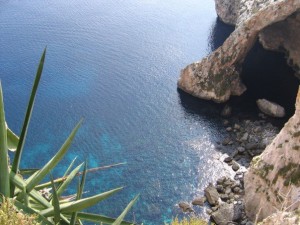 I mentioned being struck by colors at the beginning of this post – and indeed, my sensory exploration continued during the latter part of my trip. The Blue Grotto, a sea cave on the southern coast of Malta, was one such place. Now while one might im
I mentioned being struck by colors at the beginning of this post – and indeed, my sensory exploration continued during the latter part of my trip. The Blue Grotto, a sea cave on the southern coast of Malta, was one such place. Now while one might im agine the water itself to provide the luminescent blue tinge, but it is in fact the pure white sand that lends the area its unique hue. And it’s not just the water. The cave itself is home to a veritable rainbow of colors – from bright mineral yellows and oranges to deep purples, and a variety of submerged fauna.
agine the water itself to provide the luminescent blue tinge, but it is in fact the pure white sand that lends the area its unique hue. And it’s not just the water. The cave itself is home to a veritable rainbow of colors – from bright mineral yellows and oranges to deep purples, and a variety of submerged fauna.
 We end the day with some relaxation at Għajn Tuffieħa beach, a quiet beach and steep hike down to a crescent shaped promontory that is TOTALLY worth it – especially at sunset. Enjoying our relaxed states, we proceed to an outdoor restaurant at The Three Cities to enjoy first hand Malta’s maritime history coming to life.
We end the day with some relaxation at Għajn Tuffieħa beach, a quiet beach and steep hike down to a crescent shaped promontory that is TOTALLY worth it – especially at sunset. Enjoying our relaxed states, we proceed to an outdoor restaurant at The Three Cities to enjoy first hand Malta’s maritime history coming to life.
Believe it or not I never made it to Gozo, a much less developed island that is renowned for its own charms. No worries though – it provides me an EXCELLENT reason to return. . .
Having just rounded up a two-month journey courtesy of the AirAsia ASEAN pass, I thought it would be timely to reflect both on my experience of using this innovative travel resource, and my occasionally difficult adjustment from business traveler to Weekend Explorer (read, budget traveler.) #firstworldproblems
But before I launch into the tale, I acknowledge that people may not have the time to read a lengthy blog post – let alone three. So here is the key takeaway. Jetstar is the King of Budget Airlines in Asia, I will never fly AirAsia again.
Some of you may have read my post from a couple of days ago A Tale of Two Budget Airlines – Part I of III: AirAsia ASEAN Pass – the Good, the Bad, the Ugly, and How Easy it Is to Lose a Customer for Life. I know that the Internet is a pervasively negative place, and I wanted to be sure to chronicle my positive experiences alongside my struggles.
A couple of months ago, I planned an impulsive last minute trip to Singapore to surprise a friend for her birthday. Being unable to use the AirAsia ASEAN Pass due to the 14 day booking limitation, I explored alternate budget carriers as my favorite airline, Singapore Airlines, was far beyond my current price point (sob!) [Side note on SQ: those of you who want an amusing, if occasionally baffling Singlish read, this blog post from an ex-stewardess (yes, they still call themselves stewardesses, apparently!) is quite an amusing and touching read.]
Jetstar and Lion Air were the two best alternate options. But what should have been a simple booking process turned into a nightmare as neither website would accept ANY of my credit cards. Several calls to my credit card companies and multiple attempts to book later, I was ready to pull my hair out. So I called Lion Air. Being unable to accept credit card payments over the phone, they basically told me to be patient and keep trying. (Gee, thanks.)
Calling Jetstar was a completely different experience. First, they APOLOGIZED for the inconvenience caused. (I should note that to this day I’ve been unable to confirm whether the problem was at my credit cards’ end or the airlines’ websites.) Second, they proceeded to book my flight over the phone with utmost efficiency. Third, and most surprising, they followed up with an apologetic email and an IDR 500,000 voucher for future travel. At less than USD 50, this was not a huge financial hit for the company. And at around 25% of a round trip ticket to Singapore, it wasn’t even that much money to me. But this was a class act by an airline one would expect to treat its customers like cattle. And has bought my life-long loyalty – extending to its parent company, Qantas, which I have yet to have the pleasure of flying. I should add that the flight itself was a very pleasant experience – the icing on the cake in my book.
Through this experience I learned several very important things about budget travel.

Image from Slate.com
First, and foremost, not all budget carriers are the same. (Don’t take my word for it, check out Airline Ratings for alarmingly divergent safety records!)
 Second, while one expects to forgo certain perks and frills, one should not expect a reduction in basic customer service.
Second, while one expects to forgo certain perks and frills, one should not expect a reduction in basic customer service.
 Third, if you treat your customers well, you get good customers. (I judge this not only based on my own satisfaction, but on the comportment of the average Jetstar passenger vis-à-vis the average AirAsia passenger.)
Third, if you treat your customers well, you get good customers. (I judge this not only based on my own satisfaction, but on the comportment of the average Jetstar passenger vis-à-vis the average AirAsia passenger.)
And this makes all the difference in the world.
Pricing models, on the other hand, could well be another issue, not only for Jetstar (as can be seen here), but other low cost carriers as well. I am NOT a fan of opt out pricing, having an octogenarian mother and being quite sympathetic about how confusing websites can be. The airline also was recently called to task for a recent incident involving a disabled Japanese passenger who was refused carriage on a Jetstar flight from Bangkok to Tokyo. But I sincerely hope that they learn from their mistakes, and keep up the overall good work.
Read the first part of the series, A Tale of Two Budget Airlines – Part I of III: AirAsia ASEAN Pass – the Good, the Bad, the Ugly, and How Easy it Is to Lose a Customer for Life, here.
Having just rounded up a two-month journey courtesy of the AirAsia ASEAN pass, I thought it would be timely to reflect both on my experience of using this innovative travel resource, and my occasionally difficult adjustment from business traveler to Weekend Explorer (read, budget traveler.) #firstworldproblems
But before I launch into the tale, I acknowledge that people may not have the time to read a lengthy blog post – let alone three. So here is the key takeaway. AirAsia could learn a thing or two about customer service from Marriott.
One of my favorite stories behind the impetus for creating this blog involves a Marriott. Not a bad experience per se, but a disorienting time when I woke up on the third leg of an extended multi-city business trip and needed a few seconds to remember what city I was in. Because Marriotts are almost all the same. This can be comforting to the frequent business traveler who strives for a sense of normalcy on long jaunts away from home – but can also be incredibly disconcerting.
Weekend Crossroad, its writers and readers, by contrast, seek experiences. This involves embracing the unordinary, and the extraordinary, and in some ways is the polar opposite of this philosophy. But this doesn’t mean that we cannot appreciate a business model that, well, works. Or that we don’t occasionally crave the comforts of home.
Every year, my previous employer (a D.C.-based global communication and public affairs consultancy) holds a management meeting where past and future performance is discussed, clients are invited to share first-hand experience of what it’s been like working with the firm and what they expect from top-notch consultants, and guest speakers are invited to energize the team with new ideas. One year, the speaker was Kathleen Matthews, chief communications and public affairs officer (CCPAO?) for Marriott International.
Ms. Matthews (who is married to the bombastic Chris Matthews of Hardball fame) drew both from her experience as a D.C.-area news reporter/anchor and the face a Fortune 500 hospitality company. She explained that the company remains close to its roots (pun intended – the company was founded by John Willard and Alice Sheets Marriott in 1927 as a humble a root beer stand in Washington, D.C.) Marriott’s management philosophy is simple yet effective – If you take good care of your people, then they will take good care of the customer, and the customer will come back.
I’ve seen this in practice time and time again. I’ve had good experiences at Marriotts around the world, as well as some not-so-good ones. I’m presently a Silver Elite member – and while I enjoy several additional perks when staying at a Marriott, what is most important is that I’ve never felt like less of a customer during times where I did not have status (something that United Airlines could learn a thing or two from!)
All of my stories take place in Asia. I feel the need to elaborate on this point for several reasons. First, being half Chinese myself, and having led local teams in China, Malaysia, and Indonesia, I understand the immense cultural barriers that can exist when faced with a more “rah rah” style American management philosophy butts up against a deeply-entrenched sense of hierarchy. Second, it means that I know that this is not an excuse, and that anyone who uses cultural differences as an rationale for poor understanding/performance has very low awareness themselves. Third, it means that I both recognize, and appreciate, the efforts required from all sides to make things work.
My first story is several years old, and takes place at the Shanghai Marriott Hotel Hongqiao. The facilities have seen better days but are comfortable enough, and its convenient location by Hongiao airport is a major selling point. I was leading a multi-day media and spokesperson training course for the Pan-Asian executives of an American multinational company. Being a type-A anal-retentive sort, I decided that rather than grabbing a bite at the buffet lunch we had pre-booked for the participants and myself, I would see them down, grab a quick drink to take up with me, and set up for the afternoon session. As I headed out of the coffee shop with a glass of Coke in hand, a young server stopped me. “I’m sorry,” she says politely, “but guests are not allowed to take items out of the restaurant.” “I understand completely,” I reply, “but I’m part of the 20-person party over there and don’t have time for lunch. I simply wanted to take a drink up with me.” She apologized again, and I handed over the glass without another thought. (After all, it IS a completely reasonable policy.) As I’m setting up flip charts and markers in the conference room upstairs, I hear a knock at the door. I see a woman in a neat black suit, carrying a tray with a glass of ice and a can of Coke. Her tag reads “assistant manager,” and she says “I couldn’t help noticing your exchange with the server downstairs, and I wanted to apologize personally for the misunderstanding. It is our policy not to allow guests to remove food or beverages from the coffee shop, but I understand that you are busy and I hope that this will make up for that in a small way.” I was completely speechless. After making sure that she knew that I in no way blamed the server for her actions, I took the drink and sat down to think. Wow. Not only was this a first-rate service action, but how amazing that a junior manager at a restaurant in a Chinese hotel felt comfortable taking initiative to make a not-even-unhappy customer feel valued. For an approximately 25 US. cent can of soda, this individual invested in life-long loyalty. (And gave me fodder for future client service training sessions!)
My second story take place a little over a month ago, at the Mulu Marriot Hotel & Spa. Having just “endured” the wild Borneo jungle along the Kinabatangan River in Sabah (I say “endured” because I was attacked by leeches, among other critters, but have put it in quotes because the truth is I enjoyed every minute of the experience!), I decide that I have had enough of roughing it and am looking forward to a comfy bed at the end of each day of trekking through Mount Mulu National Park. (A separate post on this incredible experience is forthcoming.) Mulu is an interesting place, and well deserves its UNESCO World Heritage status. But after a particularly strenuous trek, I am disappointed because the “Spa” part of the name refers to a building – with no therapists in it. I am slightly miffed because, truth be told, the Spa part was one of the more compelling reasons why I chose this particular hotel. However, learning that my next stop would be one night at the Miri Marriott Hotel & Spa, the staff kindly contacted the Spa on my behalf to ensure that I had a booking there upon my arrival.
Another challenge was eating. Every hotel/restaurant in Mulu is faced with the same challenge – supply. Food is flown in daily from Miri (explaining the giant Styrofoam coolers on the baggage carousel at both ends of the journey.) This means frequent shortages – even at the Marriott. However, this is explained cheerfully by the staff, and the kitchen does its best to keep customers happy.
The two things that really stuck out were separate encounters I had with various staff. The first, a young Australian manager involved with the opening of the hotel (recently acquired by Marriott in a rather dilapidated state), told me of how he was assigned to oversee the transition, and that meant staying until the formal opening (the resort is still operating at a “soft opening” stage). His job entailed everything from making sure my water glass and coffee mug were filled at all times, to supervising vegetable buys, to negotiating permits with the local government. No job was to big – or too small – for his attention.
My second encounter was with two young Malaysians who worked at the hotel’s sister property in Miri. They were there to experience the park – in order to be able to report first hand on the itineraries they were booking for guests. While taking their jobs seriously, they also believed in having fun. Doing a final trek before jumping on an afternoon puddle-hopper back to Miri, one of them bemoaned not having packed a bathing suit to enjoy swimming in the aptly-named Clearwater River. After a few minutes’ consideration, she threw caution to the wind and leapt in – clothes and all. “I can sit on a towel” she reported cheerfully. “This was totally worth it.”
My third story is from just last week. At two separate stays at the JW Marriott Hotel Medan, I had two entirely different experiences. My first was a disaster. Check-in took ages, neither the A/C nor the minibar in my room worked, and I called down for ice in an effort to cool down (Medan is many things, and steamy is chief among them!) The icing on the cake was when a young boy from housekeeping (he looked about 18!) handed me a shopping bag full of ice. “Umm, do you have an ice bucket?” I ask. He looks perplexed for a moment, and then says “No.” I ask whether this was purified ice, and am greeted with a blank stare. “Never mind,” I say. I thank him and send him on his way. At this point I am quite peeved. It’s no so much that I am frustrated at being at a 5-star hotel with thus far 2-star service – it’s that JW Marriott is supposed to be the hotel’s premier chain! Hardly believing this latest experience, I take a quick photo of the plastic bag with my mobile phone and post it on my personal Twitter feed, tagging Marriott International. Within a few hours I have a reply from their global customer service, apologizing profusely for the experience and asking for me to send a private message with my reservation number. But, I’m ashamed to say, I am heading out to the jungle of Bukit Lawang early the next morning and decide to head to bed instead.
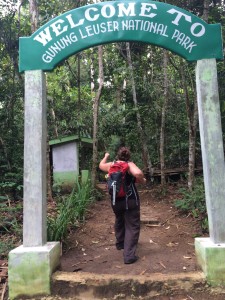
Don’t take my word alone — Jennifer braving the entrance to the jungle of Gunung Leuser National Park.
After an enjoyable, if grueling four days in the jungle, I am looking forward (somewhat paradoxically) to a hot shower and cold A/C. As I limp into the lobby, the woman at the door smiles brightly and greets me with a “welcome back!” (I had asked her for directions on my previous stay and she clearly remembered me, which impressed me to no end!) I shuffle up to the reception desk where the clerk, who also remembers me, tells me that they had been expecting me the previous day. Stupid me, I had booked the wrong night, forgetting that May has 31 days, not 30. (Yes, I STILL do the knuckle counting trick to calculate the days of the month! But clearly not this time.) Now this was 100% my fault, and it would have been within the hotel’s right to charge me for this erroneous stay AND kick me out that same night. But they didn’t. Not only did they cancel my previous reservation with no penalty – they instantly booked me a new room, noting all of the preferences in my profile, and upgraded me to a suite. Noting my profound embarrassment and profuse apologies, the clerk smiled and told me that this happens more than one would think, and that she was just happy to be able to help me. Wow. Am I glad that I didn’t write a nasty Trip Advisor review about my first stay! So you can bet that Marriott will again be my hotel of choice when I resume business travel next year.
As a wise, if ineloquent person once said, “Shit happens.” But damn if this company doesn’t get it right almost every single time.
Having just rounded up a two-month journey courtesy of the AirAsia ASEAN pass, I thought it would be timely to reflect both on my experience of using this innovative travel resource, and my occasionally difficult adjustment from business traveler to Weekend Explorer (read, budget traveler.) #firstworldproblems
But before I launch into the tale, I acknowledge that people may not have the time to read a lengthy blog post – let alone three. So here is the key takeaway. Jetstar is the King of Budget Airlines in Asia, I will never fly AirAsia again.
Now on to our story.
First, kudos to AirAsia’s marketing team. They are definitely unsurpassed in the Asian budget airline realm for coming up with innovative and attractive campaigns for the masses – of which I am but one. The AirAsia ASEAN Pass is one such initiative.
As the first promotion since the fatal Dec. 28 crash of AirAsia 8501 (which killed all 162 people on board enroute from Surabaya to Singapore) it was important for the ASEAN Pass to manifest a vision beyond cheap travel. Thus, Air Asia Group CEO Tony Fernandes explained, in advance of this year’s anticipated ASEAN Economic Community and Open Skies Policy, “the [ASEAN] pass allows us to bridge communities and attract more foreign tourists to the region. It’s the perfect instrument to promote ASEAN integration.” I should add that I had the privilege of meeting Mr. Fernandes at the World Economic Forum on East Asia in Manila last year, and that we had a charming and witty conversation about Malaysian politics. I respect him, and his accomplishments, immensely. But would that be enough to save AirAsia this customer?
 Bu
Bu t I am getting ahead of myself. What was the promotion that launched this saga in the first place? In a nutshell, the AirAsia ASEAN Pass is a pre-purchased travel pass that allows travelers to book air journeys with credits, at least 14 days or more before the departure date to travel to more than 140 routes across ASEAN’s ten member states. Travelers can opt for a 10 credit/ one month pass for MYR 499, or a 20 credit / two month pass MYR 888. The clock starts counting down from the first day of travel, not date of purchase. The two step process works as follows.
t I am getting ahead of myself. What was the promotion that launched this saga in the first place? In a nutshell, the AirAsia ASEAN Pass is a pre-purchased travel pass that allows travelers to book air journeys with credits, at least 14 days or more before the departure date to travel to more than 140 routes across ASEAN’s ten member states. Travelers can opt for a 10 credit/ one month pass for MYR 499, or a 20 credit / two month pass MYR 888. The clock starts counting down from the first day of travel, not date of purchase. The two step process works as follows.
As a relatively early adopter, I was able to capitalize on a number of advantages from the 20 credit pass. This worked for me primarily because of my own scheduling flexibility. At my time of purchase, eligible flights below two hours were valued at one credit, while flights of two hours and above were valued at three credits. However, the number of one credit flights has decreased since then, as has flight availability. (Non-Malaysian travelers may be able to take advantage on the ringgit’s recent drop vis-à-vis the USD and still enjoy discounted travel benefits.)
I took four separate (AMAZING) trips with the pass – Singapore, Borneo (Kota Kinabalu, Sandakan, Bandar Seri Begawan, Miri and Kuching), North Sumatra (Medan), and Kuala Lumpur. There were some minor hiccups here and there (mostly due to fluctuating availability and the unpredictable performance of the AirAsia website). But the REAL nightmare happened on the final leg of the journey – prompting me to write this post.
Challenges began when, as usual, I tried to pre-book 20k of check-in luggage for each leg of the journey. (I’d had no problems booking Singapore and Borneo, but Medan and Kuala Lumpur were proving to be a huge headache.) It just WASN’T working, no matter what I did. So I tried to get in touch with AirAsia customer service to resolve this seemingly benign issue.
Attempt 1: Live Chat
 Air Asia’s live chat option is a great, cost effective way to communicate with irate/frustrated customers – in theory. The challenges are as follows. First, the queues are horrendous – lasting anywhere from 45 to 90 minutes (in my four attempts over the course of several days, anyway.) Second, if you are not vigilantly at your computer for every waking moment of this time, you instantly lose your place. (I made the mistake of taking a bathroom break to discover that my computer had gone to sleep and I was kicked out of the queue with only 10 minutes to go!) No problem, this was my fault. So I brilliantly set a movie to play in the background of my laptop to maintain an active connection, and went on with the mundane tasks of the day. FINALLY I got in touch with a representative, who, after learning about my problem, told me that the issue might be with my browser and/or cookies. Now I am not the most IT savvy person (by far) but even I shouldn’t have been THIS dumb. Once I cleared my history as instructed, he told me to close the browser and try again. Great advice – except closing my browser OBVIOUSLY disabled the chat. (Duh!) Now, when you register for the service, they ask for your email address and/or mobile phone number. (I’d included both.) So I waited expectantly for an email to ping or my phone to ring. Neither happened. I attempt to register for a new chat, only to find the wait time at 95 minutes. FORGET that. So I proceed to option B.
Air Asia’s live chat option is a great, cost effective way to communicate with irate/frustrated customers – in theory. The challenges are as follows. First, the queues are horrendous – lasting anywhere from 45 to 90 minutes (in my four attempts over the course of several days, anyway.) Second, if you are not vigilantly at your computer for every waking moment of this time, you instantly lose your place. (I made the mistake of taking a bathroom break to discover that my computer had gone to sleep and I was kicked out of the queue with only 10 minutes to go!) No problem, this was my fault. So I brilliantly set a movie to play in the background of my laptop to maintain an active connection, and went on with the mundane tasks of the day. FINALLY I got in touch with a representative, who, after learning about my problem, told me that the issue might be with my browser and/or cookies. Now I am not the most IT savvy person (by far) but even I shouldn’t have been THIS dumb. Once I cleared my history as instructed, he told me to close the browser and try again. Great advice – except closing my browser OBVIOUSLY disabled the chat. (Duh!) Now, when you register for the service, they ask for your email address and/or mobile phone number. (I’d included both.) So I waited expectantly for an email to ping or my phone to ring. Neither happened. I attempt to register for a new chat, only to find the wait time at 95 minutes. FORGET that. So I proceed to option B.
Attempt 2: Indonesia Customer Service Hotline
 I get through to the call center relatively quickly, only to be greeted by someone with barely comprehensible English. (Now keep in mind that I’ve both lived and worked around Europe and Asia, have resided in Indonesia for 18 months, and am pretty good at deciphering different accents.) After a long back and forth, I finally manage to communicate my challenges to him, and he proceeds to pull up all of my upcoming itineraries. “No problem,” he explains, “the luggage is already booked,” which explains why I’ve had challenges trying to pay on the website. “OK,” I reply, “but why isn’t it showing up on my itinerary?” He sends me a new link, and sure enough, the luggage is right there where it should be. Phew – problem solved. Right?
I get through to the call center relatively quickly, only to be greeted by someone with barely comprehensible English. (Now keep in mind that I’ve both lived and worked around Europe and Asia, have resided in Indonesia for 18 months, and am pretty good at deciphering different accents.) After a long back and forth, I finally manage to communicate my challenges to him, and he proceeds to pull up all of my upcoming itineraries. “No problem,” he explains, “the luggage is already booked,” which explains why I’ve had challenges trying to pay on the website. “OK,” I reply, “but why isn’t it showing up on my itinerary?” He sends me a new link, and sure enough, the luggage is right there where it should be. Phew – problem solved. Right?
Well, the problem was solved for Jakarta – Medan and Medan – Kuala Lumpur. But on the last leg of my journey, after a lovely lunch with an old friend, I made my way early to the KLIA Ekspress train for the airport , since there are worse places to while away an afternoon than Kuala Lumpur International Airport. But this is where the true trials and service breakdowns begin.
I check in at a kiosk, and wonder why I have not been given an option to print out baggage tags. Oh well, no problem here – in Medan even though you CAN print out your tags at the kiosk, the ground staff end up ripping them up and printing new ones at the desk. So maybe this is a new security measure. I haul ass to the other end of the airport (for some bizarre reason the kiosks and the baggage drops are at opposite ends of the airport.) With a smile, I put my suitcase on the scale and hand over my travel documents. “Everything is in order with your boarding pass,” she explains, “but you have not pre-booked luggage. So I cannot check your bags in.” “But I have,” I say wearily, and proceed to recount the entire customer service saga to date. “Sorry,” she replies, “but if it’s not in my system, there’s nothing I can do.” “Fair enough,” I say, “but is there a supervisor I can speak with to attempt to resolve this situation?” She directs me to another counter with a long queue.
Forty five minutes later, only two people have been helped – one of whom has been yelling non-stop for 30 minutes. (I initially thought he was a complete jerk, but by the end of my own experience I was slightly more empathetic!) A little over an hour later I finally get through to the representative. “You are in the wrong line,” he tells me, “there are no supervisors here, and you actually need to go to the baggage payment counter over there.” ANOTHER line. At this point, I nearly blow a gasket I have been at this for nearly two hours, and have gotten exactly nowhere.
From arriving at the airport 3.5 hours before my flight, I am now running dangerously close to missing it. He takes one look at my face (at the threshold of bursting into tears, yelling with true rage, or hysterically laughing), and offers to walk me over to the right desk. (AirAsia staff at KLIA have an odd habit of running around to different posts so I can’t even find the initial representative who sent me on the wild goose chase to begin with!) I explain my problem to him, and he gives me the same reply – if it’s not in THEIR system, there’s nothing they can do. Oh, and there’s something else. Not only is it significantly more expensive to book luggage at the airport – there is a weight limit of 15 kg. So there is a good chance my bag won’t even make it on the flight.
As we walk over to my fourth queue of the day, I explode. (In typical Jennifer fashion, I explain in advance to the representative that I am not angry at him directly and that I appreciate his attempt to help me, but that I am overwhelmed by the obstacles I am facing given a situation that is in no way my fault.) He goes up to the counter and asks his colleague to take care of me, and then returns to his post.
Paradoxically, this is the nicest AirAsia representative I’ve dealt with so far – and this is the point where I get most irritated. Because he tells me the truth. He is very sympathetic to my plight, and agrees that it does not make sense that I would book luggage for three out of the four legs of my journey, and not the fourth. He tells me frankly that this is not the first time this has happened. But there is NOTHING he, or anyone, can do. I tell him step by step what has happened to this point, and he analyzes every misstep.
So here I am, facing missing my flight, throwing out a quarter of the contents of my check-in luggage, or. . .? He tells me that he can give me 1kg “grace” and that I can either pay a steep overweight fee or put some items in my carryon. “But” . . . , I say, being the law/policy-abiding Oregonian that I am, “you have a clear 7kg limit on hand carry luggage. Removing 5 kg of items from my bag will put me way over this.” “No problem,” he says confidentially, “we NEVER weigh hand luggage.”
So the net result – and the net weight on the damn plane – is ultimately the same. But AirAsia has lost a number of customers that day. I am one of them. (As, I’m sure, are some of the others in the “fake” supervisor queue.)
The sad thing is that this could have been resolved so easily. Having been a consultant (arguably one of the more challenging customer service jobs out there), I am truly empathetic to those sitting on the other side of the desk. Where I lose my patience, however, is when systems break down. What could AirAsia have done differently?
 Accountability. The thing that riled me the most was that at every step of the way, my challenges were someone else’s fault/problem. Not only could no one resolve my relatively minor problem – no one could even direct me on how to fix it.
Accountability. The thing that riled me the most was that at every step of the way, my challenges were someone else’s fault/problem. Not only could no one resolve my relatively minor problem – no one could even direct me on how to fix it.
 Empowerment. When you have ridiculously rigid policies, your customer service representatives end up finding their own ways to cut corners which short-change the airline and do nothing to make a customer feel valued. My check-in luggage issue was a drop in the bucket for AirAsia, but felt like the struggle for my life on my end.
Empowerment. When you have ridiculously rigid policies, your customer service representatives end up finding their own ways to cut corners which short-change the airline and do nothing to make a customer feel valued. My check-in luggage issue was a drop in the bucket for AirAsia, but felt like the struggle for my life on my end.
 Record Keeping. By far the most shocking was the admission that records are not always kept of customer service interactions – and that there is no single CRM system to link the different parts of the chain. Now perhaps Malaysians are by nature less litigious than we Americans, but wouldn’t it simply be good business practice (and common sense!?) to cover one’s tracks?
Record Keeping. By far the most shocking was the admission that records are not always kept of customer service interactions – and that there is no single CRM system to link the different parts of the chain. Now perhaps Malaysians are by nature less litigious than we Americans, but wouldn’t it simply be good business practice (and common sense!?) to cover one’s tracks?
 Quality. Traveling on a budget airline does not have to feel like a budget experience. Reflecting on my recent travels with AirAsia, two things stood out. First, I really felt like a meaningless cog in a big machine. If I were a dissatisfied customer, no worries – there a millions of others out there. Second, the quality of the passengers themselves was surprisingly low – by this I mean the seatbelts off up the minute the plane lands and elbow old ladies in the ribs to get bags variety. You get the customers you cultivate. That means fewer of me, and more of them. And who wants that?
Quality. Traveling on a budget airline does not have to feel like a budget experience. Reflecting on my recent travels with AirAsia, two things stood out. First, I really felt like a meaningless cog in a big machine. If I were a dissatisfied customer, no worries – there a millions of others out there. Second, the quality of the passengers themselves was surprisingly low – by this I mean the seatbelts off up the minute the plane lands and elbow old ladies in the ribs to get bags variety. You get the customers you cultivate. That means fewer of me, and more of them. And who wants that?
 Longevity. In the short run, this philosophy will hold true. For every one of me there are millions more in the wings. But as experiences such as mine are recounted, and, well, experienced on an exponential scale – who is left to ensure the airline’s sustainability? Certainly not the customers with the purchasing power to make a long-term difference on the airline’s bottom line. And that’s just a crying shame. . .
Longevity. In the short run, this philosophy will hold true. For every one of me there are millions more in the wings. But as experiences such as mine are recounted, and, well, experienced on an exponential scale – who is left to ensure the airline’s sustainability? Certainly not the customers with the purchasing power to make a long-term difference on the airline’s bottom line. And that’s just a crying shame. . .
Read the second part of the series, A Tale of Two Budget Airlines –Part II of III: Why Jetstar is the King of Budget Airlines in Asia, here.